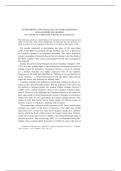ANTECEDENTS AND PARALLELS TO SOME QUESTIONS
AND ANSWERS ON GENESIS
IN VANAKAN VARDAPET'S BOOK OF QUESTIONS
The following article is a small tribute to the memory of my beloved teacher and
father in the faith, Abp. Norayr Bogharian. It represents the first portion of a
study in which we were engaged at the time of his death in December, 1996.
For people interested in determining the place of the apocryphal
books of the Bible in Armenian literary tradition, the Book of Questions
by Vanakan vardapet is an important document. This article intends to
present a sampling of material drawn from it, relating to the first book of
the Bible, together with sources and parallels for the ideas contained in
that material.
During the period of the Mongol invasions Vanakan vardapet (1181-
1251) was the guiding light of the northeastern Armenian province of
Ganjak, where his monastery, Xoranasat, became a center of learning.
As a teacher Vanakan was highly respected. One of his students,
Step‘anos of A¥t‘amar, described him as “Shining in our age like the star
of the morning… a cloud bedewing [us] with the Spirit, daily pouring
down the divine and watering the rational earth”1.
Vanakan embodies the indigenous intellectual tradition of eastern Ar-
menia in the early thirteenth century. But the influence of his ideas was
not limited to Armenia proper; his student Vardan vardapet Arewelc‘i
(1200?-1271) carried Vanakan's ideas to the southern Armenian king-
dom of Cilicia as well. Although the Vanakan tradition in the south was
later superseded by more Europeanized trends of thought, it nonetheless
formed the basis for two generations of Cilician intellectual life. This
makes it more than likely that in future studies of Cilician works on
Genesis, echoes of Vanakan's opinions will be found.
The manuscripts collection of the monastery of St. James in Jerusalem
contains two copies of the Book of Questions. The older one, J1288
dates from 1273, twenty-two years after Vanakan's death. It is a Miscel-
lany in which the Book of Questions is the longest single item. Unfortu-
nately, this manuscript was not available to me during the preparation of
the present article. The second copy, J587, is a seventeenth century Mis-
cellany whose contents differ from those of J1288. Its copy of the text of
1
Colophon to Ejmiacin ms. 2093/2101. Cited in Garegin YOVSEP‘IANC‘, Yisataka-
rank‘ Jeragrac‘, vol. I, Antelias, 1951, col. 827.
, 418 R. ERVINE
Vanakan's Book of Questions seems to be from a different exemplar
than that used by J1288, but its accessibility and comparative legibility
made it the basis for the present discussion.
In each of the two Jerusalem manuscripts, several pages have been
displaced, and perhaps another one or two pages have been completely
lost. At what point in the transmission these accidents occurred is not
certain, and not all of the lapses can be corrected on the basis of internal
evidence. The Mastoc‘ Matenadaran Institute of Ancient Manuscripts in
Erevan, Armenia has a copy of the Book of Questions made in 1255 (ms.
M6106), just four years after Vanakan's death, by the scribe Grigoris at
the commission of T‘ade and Hayrapet. When this becomes available to
me, I expect that it will clarify these problems.
The topics addressed by the Book of Questions are almost exclusively
biblical, though there are also more broadly religious questions concern-
ing works by Philo and others. Among the many biblical questions ad-
dressed, J587's text contains some one hundred fifty-six queries con-
cerning the first fourteen chapters of Genesis. This number does not in-
clude questions on the typological correspondences between the Old and
New Testaments.
Although the questions tend to fall together in blocks, there seems to
be no special order to them overall. Taken together, they do not consti-
tute a commentary on the book of Genesis. The form of the questions
and their answers is succinct, sometimes even cryptic. They were obvi-
ously recorded by someone who was able to reconstruct the whole of
what had been said on the topic from brief notations. Fourteen of the
questions are recorded more than once, not always with the same an-
swer, indicating that the collection was not composed at a single sitting,
with a unified plan in mind, but was compiled over a period of time. Of
the repeated questions, all but one concern Adam and Eve. In fact, of the
total one hundred fifty-six questions, ninety deal with Adam and Eve
and the Fall. In addition to the questions and their responses, there are
also several paragraphs not in question and answer form, which also
present material relevant to Genesis. Finally, there are a further eight
questions on Genesis in a section near the end of the manuscript, which
may not actually be attributable to Vanakan.
Some of the questions are standard, and receive standard answers. For
example, the question “Why was Eve not taken from Adam's head?”
receives the standard answer, “So that she would not be superior to
him.” And the question “Why was she not taken from his feet?” has as
its response the standard statement, “So that she would not be his serv-
ant.” Such questions as these are not of concern here.





